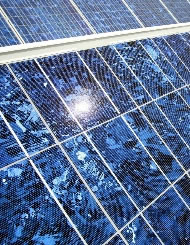 Could India become a solar leader?Jun 5, 2009 - James Kanter - The New York Times
Called the National Solar Mission, the Indian plan outlines a target for 20,000 megawatts of solar capacity by 2020, according to a draft copy obtained by Greenpeace and posted to the Web. “This would be the most ambitious solar plan that any country has laid out so far,” said Siddharth Pathak, a climate and energy campaigner for Greenpeace India. India would generate 100,000 megawatts of solar power by 2030 and 200,000 megawatts by mid-century under the plan. The plan acknowledges the high cost of solar compared with other sources of energy, and coal in particular. But it says costs could be driven down to between 4 and 5 rupees per kilowatt hour by the period 2017-2020, making solar cost-competitive with fossil fuels. There would be one million rooftop systems with an average capacity of 3 kilowatts by 2020 to cut the use of diesel for daytime power while generation parks could be built in the “exclusion” zones around nuclear plants, where people are not allowed to live but solar facilities could be safely installed. Crucial to the project would be building up local manufacturing capacity. The plan envisages training 100,000 specialists by 2020. It also foresees the need for processing facilities for raw materials, factories and technology parks for making components and equipment and generation parks to produce electricity. India can now make 700 megawatts of photovoltaic modules each year, according to the plan. The aim would be to make 20,000 megawatts of solar cells annually by 2017 and to establish expertise in solar thermal technologies. Total costs would be 85,000 and 105,000 crores ($18.5 billion to $22.8 billion) over a 30-year period. To help finance the project, the plan foresees a significant tax on gasoline and diesel — fuels the government currently subsidizes. The plan also foresees a feed-in tariff, solar power purchase obligations for Indian authorities, tax breaks for manufacturers, and exemptions on tariffs for imported equipment. A so-called Solar Energy Authority of India would be set up to manage the system. But Greenpeace emphasized that help from rich countries would be essential for India to meet its goals. “India needs international support,” Mr. Pathak said. “The industrialized world needs to come up with solid proposals on technology and finance to help developing countries deliver on ambitious plans like this one,” he said. |
Email this page to a friend


 India may be gearing to turn itself into the global leader in solar power generation, a sign that major developing nations could become renewable energy hubs to rival Germany and the United States.
India may be gearing to turn itself into the global leader in solar power generation, a sign that major developing nations could become renewable energy hubs to rival Germany and the United States.